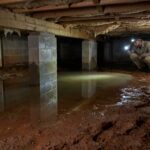Essential Guide to Effective Foundation Repair: Ensuring Long-Term Stability for Your Home
When it comes to homeownership, the foundation of your house isn’t just a part of the structure; it’s the backbone that supports everything else. A weak foundation can lead to a host of problems, including cracked walls, uneven floors, and those delightful doors that seem to develop a mind of their own. So, unless you’re a fan of living in a funhouse, it’s crucial to understand effective foundation repair methods. This guide will take you through the essential steps to ensure the long-term stability of your home, while hopefully keeping your sense of humor intact during this serious business.
Understanding the Importance of Your Foundation
Before we dive into repair methods, let’s talk about why your foundation is so important. Your home’s foundation bears the weight of the entire structure and keeps it level and stable. It’s like the unsung hero of your household—working hard behind the scenes, rarely appreciated until things start to go awry.
A solid foundation protects against pests, moisture intrusion, and even severe weather conditions. In short, it’s the rock under your metaphorical boat (and, if you’ve ever seen a boat that’s taking on water, you know what I mean). When you neglect foundation issues, you’re setting yourself up for a series of problems that could cost you time, money, and possibly your sanity.
Common Signs of Foundation Problems
So, how do you know if your foundation is crying out for help? Here are some telltale signs that something might be amiss:
1. **Cracks in Walls and Ceilings**: If you’re suddenly channeling your inner Picasso with large cracks spreading across your walls, it’s time to investigate. Small cracks may not be a cause for concern, but large or growing ones should alert you.
2. **Uneven Floors**: If walking across your living room feels more like an obstacle course, you could have a sinking or shifting foundation.
3. **Doors and Windows That Stick**: Have your doors and windows developed a mysterious resistance? They might just be trying to keep you inside. More likely, there’s a foundation issue at play.
4. **Basement and Crawl Space Problems**: If water is pooling in your basement or crawl space, it’s a sign of poor drainage or structural issues.
5. **Gaps Between Walls and Ceilings**: If you’re noticing gaps appearing where your walls meet the ceiling, it’s a sign that your home might be settling improperly.
If you spot one or more of these indicators, don’t panic! Just grab your detective hat and let’s get to the bottom of it.
Assessing the Situation
Before diving into repairs, it’s essential to assess the situation. You might feel like a surgeon preparing for an operation, but fear not! Here’s how to carry out your assessment:
1. **Visual Inspection**: Walk around your home, both inside and outside. Look for cracks, gaps, and other irregularities mentioned earlier. Take notes as evidence—even detectives need their case files!
2. **Check Drainage**: Ensure that gutters and downspouts are functioning correctly and directing water away from your foundation. Much like listening to a friend who has way too many problems, water needs to move on instead of pooling around your home.
3. **Soil Condition**: The type of soil under your home plays a significant role in foundation stability. Clay soils can expand and contract, leading to movement. If you’ve got a garden, think of it as the soil’s mood swings affecting your foundation.
4. **Professional Assessment**: Sometimes the best medicine is professional advice. If you’re unsure of your findings or if the damage seems extensive, calling a foundation expert is wise. Think of them as the superhero in a cape—albeit a dirty one!
Types of Foundation Repairs
Once you’ve assessed the situation, it’s time to consider your options. Just like choosing a pizza topping, not all methods are created equal. Every foundation problem is unique, and so are the solutions. Here are some common foundation repair methods:
1. **Piering**: This method involves installing piers deep into the ground to support your foundation. Think of piers as your home’s new best friends, giving it the lift it needs when it’s feeling down.
2. **Slabjacking**: If you have a concrete slab foundation that’s settled, slabjacking involves injecting a strong foam beneath the slab to raise it back into position. It’s like giving your foundation a couple of espresso shots to wake it back up!
3. **Wall Anchors**: For bowing walls, wall anchors can provide support. These are installed through the exterior of your home, anchoring the wall in place. Kind of like putting a sturdy belt on those pants that always seem to sag.
4. **Grading**: If water pooling is an issue, grading the land around your foundation can direct water away and prevent further erosion. A little landscaping can go a long way in safeguarding your home.
5. **Drainage Solutions**: Installing drain tiles or sump pumps can help manage water flow and keep your foundation dry. It’s essentially giving your home a waterproof raincoat—because no one likes soggy socks!
Preventative Measures
Now that you’ve fixed the current issues, it’s time to think about preventing future problems. After all, prevention is better than cure! Here are some steps to take:
1. **Regular Inspections**: Conducting annual inspections of your foundation can catch problems early. Sometimes it pays off to play detective before things spiral out of control!
2. **Maintain Gutters and Downspouts**: Clean out your gutters regularly to avoid clogs, ensuring water flows away from the foundation. Consider this the equivalent of keeping your home’s plumbing clean—invaluable for long-term health.
3. **Proper Landscaping**: Ensure plants are planted a safe distance from the foundation. The last thing you want is roots creeping in where they don’t belong, acting like unwanted guests at a party!
4. **Soil Stabilization**: To combat soil movement, consider using additives that promote soil stability. This is like putting a seatbelt on your foundation—safety first!
5. **Install a Sump Pump**: If you live in a flood-prone area, a sump pump can be a lifesaver. Just think of it as your foundation’s personal lifeguard.
Taking Action
If, after assessment, you decide it’s time for repairs, don’t hesitate to act. Ignoring foundation issues is like ignoring a flat tire; eventually, you’ll find yourself stranded. Remember to consult professionals if needed, especially for extensive repairs or structural work.
And always keep in mind: While DIY projects can be rewarding, some things are best left to the experts. Letting the pros handle intricate repairs could save you time, energy, and, potentially, a lot of cash in the long run.
In Conclusion
Your home’s foundation is critical to its overall stability and your peace of mind. Recognizing problems early and taking action can save you from more costly repairs down the line. Whether you’re dealing with cracks, uneven floors, or pesky water issues, understanding your options for foundation repair is essential.
So, as you embark on this journey to ensure the longevity of your home, remember to assess the situation, explore repair options, and take preventative measures. Your foundation—and your future self—will thank you for it! After all, a stable foundation is the cornerstone of a happy home. And who wouldn’t want that?


